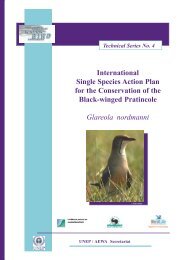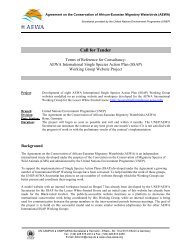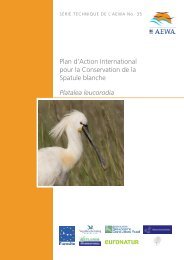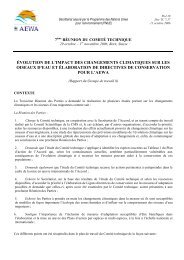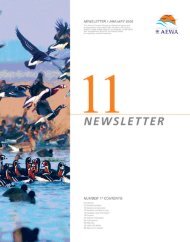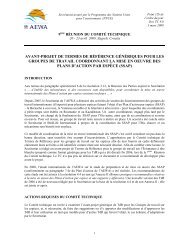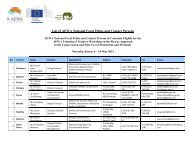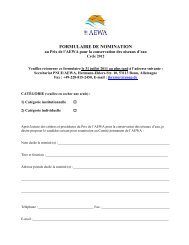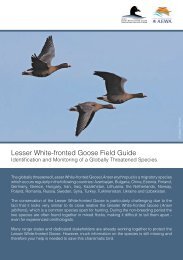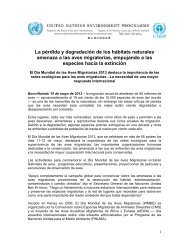The quick brown fox jumps over the lazy dog - AEWA
The quick brown fox jumps over the lazy dog - AEWA
The quick brown fox jumps over the lazy dog - AEWA
You also want an ePaper? Increase the reach of your titles
YUMPU automatically turns print PDFs into web optimized ePapers that Google loves.
Secretariat provided by <strong>the</strong><br />
United Nations Environment Programme (UNEP)<br />
Doc StC 7.DR6 Rev.1<br />
Agenda item 19<br />
11 November 2011<br />
7 th MEETING OF THE <strong>AEWA</strong> STANDING COMMITTEE<br />
26 – 27 November 2011, Bergen, Norway<br />
DRAFT RESOLUTION 5.XX<br />
REVISION AND ADOPTION OF CONSERVATION GUIDELINES<br />
Recalling Article IV paragraph 4 of <strong>the</strong> Agreement, and paragraph 7.3 of <strong>the</strong> Agreement’s<br />
Action Plan, which require <strong>the</strong> development and review of conservation guidelines so as to assist<br />
Contracting Parties with <strong>the</strong>ir implementation of <strong>the</strong> Agreement,<br />
Fur<strong>the</strong>r recalling Resolutions 1.10, 2.3 and 4.13, which adopted 13 conservation guidelines<br />
focusing on various aspects of waterbird conservation practice,<br />
Noting that <strong>the</strong>se conservation guidelines provide a common framework for action, which aids<br />
<strong>the</strong> coherent implementation of <strong>the</strong> Agreement by <strong>the</strong> Contracting Parties to <strong>the</strong> Agreement, as well as<br />
o<strong>the</strong>r Range States and interested parties,<br />
Recognizing <strong>the</strong> work of <strong>the</strong> Secretariat and <strong>the</strong> Technical Committee <strong>over</strong> <strong>the</strong> past triennium<br />
to review previously adopted conservation guidelines and develop additional ones, also in<br />
collaboration with <strong>the</strong> Convention on Migratory Species (CMS) and <strong>the</strong> CMS MoU on <strong>the</strong><br />
Conservation of African-Eurasian Birds of Prey,<br />
Acknowledging <strong>the</strong> voluntary contribution by <strong>the</strong> G<strong>over</strong>nment of Switzerland and <strong>the</strong> funds<br />
provided by RWE Rhein-Ruhr Netzservice GmbH, which enabled <strong>the</strong> development of additional<br />
guidelines,<br />
Recalling Resolution 4.3 which requested <strong>the</strong> Technical Committee to review <strong>the</strong> periods<br />
during which huntable bird populations of conservation concern c<strong>over</strong>ed by <strong>the</strong> Agreement return to<br />
<strong>the</strong>ir breeding grounds and, if needed, to provide fur<strong>the</strong>r guidance on <strong>the</strong> implementation of paragraph<br />
2.1.2 (a) <strong>AEWA</strong> Action Plan,<br />
Recognizing <strong>the</strong> work of <strong>the</strong> Technical Committee <strong>over</strong> <strong>the</strong> past triennium towards developing<br />
guidance on <strong>the</strong> definition of periods of breeding and pre-nuptial migration for migratory African-<br />
Eurasian waterbirds (document <strong>AEWA</strong>/MOP Inf. 5.XX).<br />
<strong>The</strong> Meeting of <strong>the</strong> Parties:<br />
1. Adopts <strong>the</strong> following newly developed conservation guidelines:<br />
a) Guidelines for mitigating/avoiding <strong>the</strong> conflict between migratory birds and electricity<br />
power grids (document <strong>AEWA</strong>/MOP 5.XX), and<br />
b) Guidelines on re-establishment of <strong>AEWA</strong> waterbird species (document <strong>AEWA</strong>/MOP<br />
5.XX)<br />
in <strong>the</strong> sense of Article IV of <strong>the</strong> Agreement, as guidance for <strong>the</strong> Contracting Parties in <strong>the</strong><br />
implementation of <strong>the</strong> Agreement and its Action Plan;
2. Adopts <strong>the</strong> revised versions of <strong>the</strong> following previously adopted conservation guidelines:<br />
a) Guidelines on identifying and tackling emergency situations for migratory waterbirds<br />
(document <strong>AEWA</strong>/MOP 5.XX),<br />
b) Guidelines on regulating trade in migratory waterbirds (document <strong>AEWA</strong>/MOP 5.XX),<br />
and<br />
c) Guidelines on avoidance of introductions of non-native waterbird species (document<br />
<strong>AEWA</strong>/MOP 5.XX);<br />
3. Calls upon Contracting Parties, as before, to utilize <strong>the</strong>se guidelines in a practical way that<br />
leads to a minimum of additional bureaucracy and that recognizes <strong>the</strong> different social, economic and<br />
environmental conditions within <strong>the</strong> Agreement area;<br />
4. Instructs <strong>the</strong> Secretariat to disseminate <strong>the</strong>se guidelines to all Range States, and relevant<br />
international g<strong>over</strong>nmental and non-g<strong>over</strong>nmental organisations, and to monitor <strong>the</strong>ir use to <strong>the</strong> extent<br />
that this is possible;<br />
5. Encourages Contracting Parties to utilize <strong>the</strong> guidance on defining periods of breeding and<br />
pre-nuptial migration for migratory African-Eurasian waterbirds with respect to <strong>the</strong> implementation of<br />
paragraph 2.1.2 (a) <strong>AEWA</strong> Action Plan (document <strong>AEWA</strong>/MOP Inf. 5.XX);<br />
6. Requests <strong>the</strong> Technical Committee and <strong>the</strong> Secretariat to integrate this guidance in a future<br />
revised version of <strong>the</strong> Conservation Guidelines on sustainable harvest of migratory waterbirds.<br />
2



